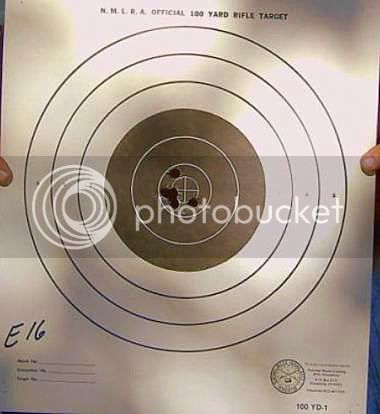For a time quite a few years ago I belonged to a group which shot at a very nice indoor range. We had monthly shoots, no competition, just a friendly gathering where only BP shooters were in the range. One evening I was shooting my .40 flintlock rifle, working on offhand targets and doing better than average for me. One of the young men in the bunch who was the current and past Kentucky offhand flintlock champion came over and admired the way the gun shot, asked if he could shoot a group with it. I loaded the gun for him each time and watched him absolutely eat the X out of the target. He said the gun was shooting very well, but he thought it would do better with a tighter patch-ball combination. I was shooting .395” balls with a .015” linen patch, and he suggested I go to a .400” ball with the same patch. The gun had a Douglas barrel with a land diameter of .403”. I tried what he suggested, and even I could see there was an improvement in the accuracy from the bench. That was a hard-to-load combination, though, so I soon went back to my regular setup. The .395” ball required a smart smack on the short starter, and the .400” sometimes required several
I’ve seen that many shooters believe accuracy increases as tightness increases, and have been curious why that might be true. What mechanism comes into play to cause the improvement? I can only think of two major possibilities, but would like to hear what the board thinks.
Number one, it seems obvious that the greased patch only partially seals the gasses behind the ball so that some gas always blows past the ball. Because of the way the patch folds and compresses differently each time, the amount of gas escaping can vary from shot to shot. The more gas which escapes, the lower the pressure and velocity. Variation of velocity is not compatible with high accuracy. Tighter patch-ball combos create a better seal, makes the blow-by more consistent.
Number two, The really tight combination forces the spherical ball into a slight cylindrical shape, with some slight length. When long bullets are properly stabilized by the spin induced by the rifling, accuracy goes up.The spin rate required for stabilization is inversely proportional to bullet length, longer bullets require quicker spin, short bullets tolerate slower spin. With really tight combinations we are shooting very short bullets instead of balls.This could be why such slow spin rates work well with ball guns.
What say ye?
Spence
I’ve seen that many shooters believe accuracy increases as tightness increases, and have been curious why that might be true. What mechanism comes into play to cause the improvement? I can only think of two major possibilities, but would like to hear what the board thinks.
Number one, it seems obvious that the greased patch only partially seals the gasses behind the ball so that some gas always blows past the ball. Because of the way the patch folds and compresses differently each time, the amount of gas escaping can vary from shot to shot. The more gas which escapes, the lower the pressure and velocity. Variation of velocity is not compatible with high accuracy. Tighter patch-ball combos create a better seal, makes the blow-by more consistent.
Number two, The really tight combination forces the spherical ball into a slight cylindrical shape, with some slight length. When long bullets are properly stabilized by the spin induced by the rifling, accuracy goes up.The spin rate required for stabilization is inversely proportional to bullet length, longer bullets require quicker spin, short bullets tolerate slower spin. With really tight combinations we are shooting very short bullets instead of balls.This could be why such slow spin rates work well with ball guns.
What say ye?
Spence







